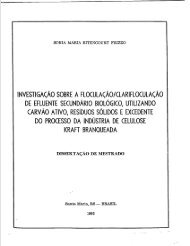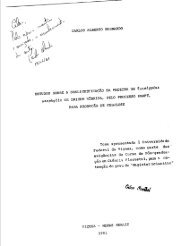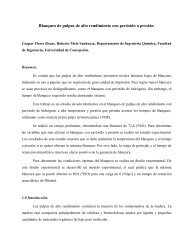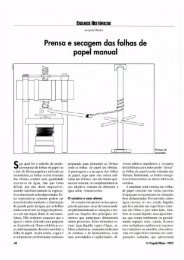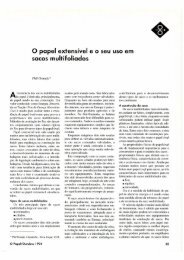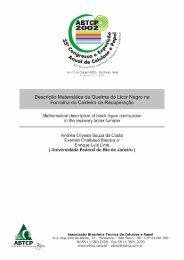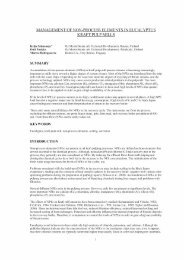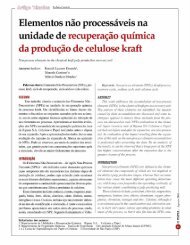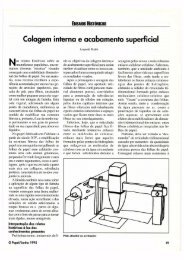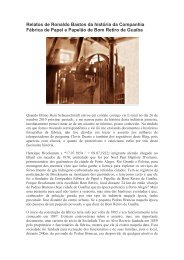O Eucalipto: um século no Brasil (The Eucalypt - Celso Foelkel
O Eucalipto: um século no Brasil (The Eucalypt - Celso Foelkel
O Eucalipto: um século no Brasil (The Eucalypt - Celso Foelkel
Create successful ePaper yourself
Turn your PDF publications into a flip-book with our unique Google optimized e-Paper software.
O E U C A L I P T O - U M S É C U L O N O B R A S I L<br />
56<br />
‘<strong>Eucalypt</strong>us’, em grego, significa “verdadeira cobertura”, e o <strong>no</strong>me tem razão de ser, pois o gênero tem<br />
mais de 600 espécies, quase todas nativas da Austrália, onde é o gênero dominante entre as árvores.<br />
Ele existe do nível do mar a 2.000 metros de altitude e é raro apenas na floresta tropical australiana.<br />
Pertencente à família ‘Myrtaceae’, a mesma da goiaba ‘Psidi<strong>um</strong> guajava’, da pitanga ‘Eugenia<br />
uniflora’ e da jabuticaba ‘Myrciaria jaboticaba’, os eucaliptos são quase todos árvores, mas<br />
alg<strong>um</strong>as espécies são arbustivas, e só 15 espécies são originárias de outros países, <strong>um</strong>a de Timor,<br />
outra das Filipinas, e há eucaliptos também na Nova Guiné e na Indonésia.<br />
Vulgarmente conhecidos como ‘g<strong>um</strong> trees’, isto é, árvores da goma, o eucalipto deve esse apelido<br />
ao fato de que na terra de origem muitas das espécies soltam por qualquer ferimento bastante<br />
seiva e resina com <strong>um</strong> odor muito forte, o que não impede que as folhas da árvore sejam comidas<br />
pelos coalas e gambás, bem como atacadas por vários tipos de insetos.<br />
A velocidade de crescimento do eucalipto fez com que há muito tempo o gênero tenha sido<br />
exportado para países que precisavam repor suas árvores. Em 1850 imigrantes australia<strong>no</strong>s<br />
que chegaram aos Estados Unidos levaram eucalipto, que fez muito sucesso, ocupando vários<br />
milhões de hectares até 1900, quando a planta começou a ser criticada por ocupar o lugar das<br />
nativas. Na realidade o descrédito do eucalipto pareceu decorrer da dificuldade de transformálo<br />
em tábuas, já que as tensões de crescimento o rachavam.<br />
A Etiópia importou o eucalipto em 1894, quando o imperador Menelik II trouxe a essência para reflorestar<br />
os arredores de Adis Abeba, completamente desflorestados pela população que precisava de lenha.<br />
‘<strong>Eucalypt</strong>us’, in Greek, means “true coverage,” and there is good reason for the name, since<br />
there are more than 600 species in the genus, the near totality of which native to Australia,<br />
where eucalypt is the dominating genus among the trees. It grows from sea level to 2000 meters<br />
above it, eucalypt is only scarce in the Australian rainforest.<br />
Belonging to the ‘Myrtaceae’ family, the same family as the guava, ‘Psidi<strong>um</strong><br />
guajava’, of the pitanga, ‘Eugenia uniflora,’ and of the jabuticaba ‘Myrciaria jaboticaba,’<br />
eucalypt plants are nearly always trees, although a few species are brushes, and only 15<br />
species are native of other countries, one of Timor, a<strong>no</strong>ther from the Philippines, and there<br />
is also eucalypt in New Guinea and in Indonesia.<br />
Commonly k<strong>no</strong>wn as ‘g<strong>um</strong> trees,’ eucalypt got this nickname from the fact that<br />
in their native land many species release an abundant, highly odoriferous sap and resin<br />
through any open injury, something that does <strong>no</strong>t prevent the tree’s leaves from being eaten<br />
by koalas and skunks and attacked by insects.<br />
<strong>Eucalypt</strong> great growth speed led the tree, a long time ago, to be exported to countries<br />
that needed to replace their trees. In 1850, Australian immigrants arriving in the US took<br />
eucalypt with them, where it was very successful and occupied several million hectares through<br />
1900, when the plant started getting criticized for occupying the native plants’ places. In fact,<br />
eucalypt seemed to be discredited much more because of the difficulty associated to turning it<br />
into boards, since growth tensions cracked the wood.<br />
Ethiopia imported eucalypt in 1894, when emperor Menelik II brought the specie<br />
to reforest the area neighboring Adis Abeba, which had been completely deforested by the<br />
population that needed firewood.




